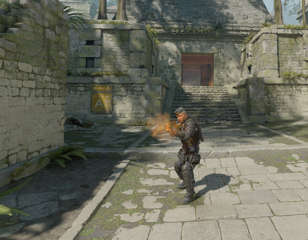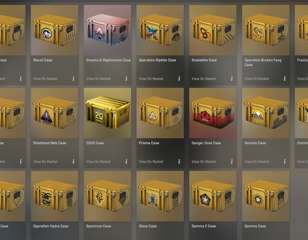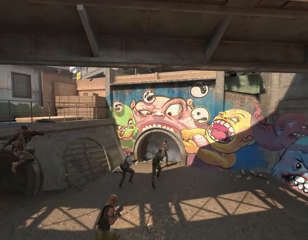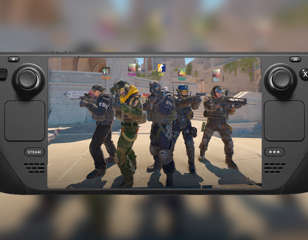
stuchiu: The Longevity of Counter-Strike
We decided to take a retrospective look on what it means to be a “living” or “dead” esports and the longevity of CS:GO.
18th Mar 2020 20:00
This is part of the ‘Counter-Strike’ directory
Directory contents
-
Best Graphics Settings
-
Pro Crosshair Codes
-
Best Launch Options
-
Bob Settings
-
Change Brightness
-
Jumpthrow Bind
-
Left-Hand View
-
Stretched-Res
-
Hide UI
-
VALORANT Sensitivity
-
Show FPS
-
Crosshair Customisation
Recently CS:GO hit a record high of 1,000,000 players on steam. It is likely a result of various factors, among which the game going free-to-play is likely the biggest factor. With the game reaching its height of popularity 20 years into its lifespan, I decided to take a retrospective look on what it means to be a “living” or “dead” esport and the longevity of CS:GO.
What is a dead game?
Dead game is an often circulated meme in the esports space. Though the use of the term is a bit ambiguous, it’s a phrase used to denote that a game is falling into decline and out of relevance with the mainstream esports audience. For my part, the first time I ran into the phase was during the BL/infestor era of SC2 (the first one in 2012).
SC2’s decline in popularity is one of the biggest whodunit mysteries in the esports scene. No one has ever conclusively done any hard research into the subject and so when most people try to come up with an answer, it’s based on a feeling of what they think likely ended the game. There are a myriad of potential causes to choose from: The balance and meta, Korean domination, Blizzard’s lethargy, lack of a unified circuit, or a lack of narratives just to name a few. Thus people could choose whichever reason they wished to fit their own narratives.
The problem with this approach was that the question had an implicit assumption built into it. Why do we assume that the game could have continued being a top level esports game if X,Y, and Z factors hadn’t gone awry? A potential explanation for SC2’s decline is that it was inevitable. The SC2 fans of that time just moved on as the game and the esports side failed to hold their interest.
As for why, I can only speculate from my point of view. In regards to BL/infestor it was bad on multiple levels. It inhibited the dynamic gameplay that I enjoyed watching in the game, while simultaneously forcing almost every Zerg game into the boring static deathball play. It inhibited the individual expression of players as Protoss and Terran players had to go all-in before the composition finished or lose the game. What’s more the composition required no sacrifice. There was no drawback in the early or mid-game, actually it had the sturdiest early and mid-game of any Zerg style at the time. Esports that fail to allow individual expression seem to inevitably fail in the long-run and that fundamental problem leaks into all other levels of the game.
What is a living game?
Just as there has been discussion about the decline of SC2, there’s also been a lot of discussion around what constitutes an esport and at what levels. I’ll ignore the numbers for now as things like spectator size, playerpool, and overall money varies depending on what year it is.
For me, a living game has three factors. The first is its ability to draw in the casual player. While it was possible for esports games to be comprised of purely hardcore players in the past, the economics and the market don’t seem to make that model possible anymore.
The second factor is the inherent novel complexity in the game to incentivize hardcore players. There needs to be enough novelty and depth in a game so that someone can spend 10,000+ hours on a game and find that he is nowhere close to being a master of the game. While patches can help this, the inherent game itself should already provide this in the base game itself.
The third factor is individual expression. It must give players the ability to express their individual characteristics through gameplay.
Games with only the first show up and disappear like a morning fog. Games with the latter two aspects gain small, but dedicated fan bases that can sustain them through the worst of times. Counter-Strike is a game that has all three.

DreamHack Winter 2014
I’m a latecomer to the Counter-Strike scene as the first CS tournament I ever watched was DreamHack Winter 2014. Since then, I’ve slowly transitioned into having CS:GO be the primary game I like to write about. This late entrance and transition lets me articulate what is compelling about CS:GO.
As an absolute novice, the first thing that struck me about the game was how fair everything was. You could snowball a few rounds in CS:GO, but eventually the losing team could get a full buy together and fight the winning team on equal footing. In contrast in a game like SC2, if you ran over someone in the early game, it usually ended in a boring stomp if the attacker did enough damage.
What’s more, with both teams switching sides, there was no inherent imbalance of one side being stronger than the other. This was a problem in Dota2 depending on where Roshan and how the late meta worked. While there were overpowered guns like the Tech-9, it wasn’t like the Infestor which could only be used by Zerg players only.
Finally, there was a strong ebb and flow to the game. Moments and rounds built up into each other naturally. Things exploded with the pistol before slowing down and picking up again. There were natural falls in action which made for strong highs. The format, fairness, and natural visceral reaction of watching an AWP shot or headshot made the entire game fun to watch.
ESL One Cologne 2015
The tournament that made me want to write CS:GO was ESL ONE Cologne. Fnatic had pulled out my favorite type of victory. The lineup was: Jesper “JW” Wecksell, Freddy “KRIMZ” Johansson, Robin “flusha” Ronnquist, Markus “pronax” Wallsten, and Olof “olofmeister” Kajbjer. They were in that particular limelight you see all-time greats fall into at the end of their primes. Weary kings who look a bit old and a bit vulnerable on their thrones. Hyenas circling around waiting to tear them apart.
In that vulnerable moment, you get to witness their inherent greatness come to the fore. Once the king can no longer rely on strategic, tactical, or mechanical advantages. Their time has come, but they refuse and you see a certain ineffable force in them. A level of grit and defiance as they scream, not yet, not now!
Fnatic made no screams, instead it was the crowd screaming as Virtus.Pro had them on the ropes of elimination on Inferno. Fnatic made no noise, just recomposed themselves and with the dignity of the legendary champions that they were, made the comeback and then went on to win the Major.
Beyond the narrative, what this tournament told me was that this game itself had soul. That it could not only allow players to express their individual skills in the game, but it could also convey the emotional stakes of a moment and have the game deliver on those moments with extremely combative rounds that could swing either way.

Four Years Later
It’s been over four years since then and I’ve continued to study CS:GO. With each passing year, I reach a deeper understanding of the game. The dynamics of the game are endlessly fascinating as each level of understanding forces me to reinterpret what I thought I understood from the year before. Things like positioning, tactics, rotations, individual and teamplay can change dramatically depending on player and team dynamic. That dynamic has become even more complex in recent years as international teams and contractual buyouts have become part of the esports scene.
The novelty of this game comes from how open it is. There are no predefined skillsets like MOBA games for characters as every in-game avatar has the same potential as any other. The biggest limit is the individual and the team itself. Style depends on both circumstance and ability, so this game works on both an individual, tactical, and philosophical level. Players have to make certain choices and sacrifices to achieve what they want.
An example of this is the original Astralis core: Andreas “Xyp9x” Hojsleth, Peter “dupreeh” Rasmussen, and Nicolai “dev1ce” Reedtz. All three players have made role changes throughout their careers for different reasons. Xyp9x became a supportive player so that he could play alongside dupreeh and dev1ce to make one of the best cores in the world. Dupreeh shifted from entry to lurker to help Astralis win their first Major in 2017. Dev1ce took up the AWP as it was a missing element in his team and his sacrifice is that he has the responsibility of consistently performing every single game. Where Dupreeh and Xyp9x can get days off because of the roles they play, the AWP role demands a high level of performance every time the AWPer goes out.
As a game it has all three factors I talked about. The ability to appeal to casuals, the novelty and depth for hardcore players, and the potential for individual expression.
Competition as Philosophy and CS:GO’s Longevity
On top of those aspects, is the underlying allure of competition itself. Competition has been around since ancient history and in many ways we can consider competition as philosophy for those who don’t read philosophy. A set of rules are established, a goal is set, players gather around to play, and massive crowds gather to watch. It is a visceral way of watching being at work. The players then make strategic and tactical decisions to try to achieve the goal while the crowd watches them compete. It works as entertainment, but can also give cues to people on what the correct way is to act in the world.
After understanding that underlying concept of competition’s allure, we can see why CS:GO has been around for so long. It works at every level, whether it’s the basic impact of a gunshot to the nuanced details of an execution. Among team games, it is the best at balancing the dynamic between the importance of a team and the importance of an individual. Not even the greatest player ever can win a game alone, he needs a strong team around him to work. Conversely a team with good teamplay, but lacking firepower has its own limits. When you consider all of these factors, it is easy to see why CS:GO has lived on for 20 years and doesn’t seem to be slowing down anytime soon.
Images via Valve

About The Author
Stephen "stuchiu" Chiu
Stephen "stuchiu" Chiu is a Freelance Journalist at GGRecon. He has previously written for other publications like Dexerto, VPEsports, and Slingshot.
This is part of the ‘Counter-Strike’ directory
Directory contents
-
Best Graphics Settings
-
Pro Crosshair Codes
-
Best Launch Options
-
Bob Settings
-
Change Brightness
-
Jumpthrow Bind
-
Left-Hand View
-
Stretched-Res
-
Hide UI
-
VALORANT Sensitivity
-
Show FPS
-
Crosshair Customisation
























